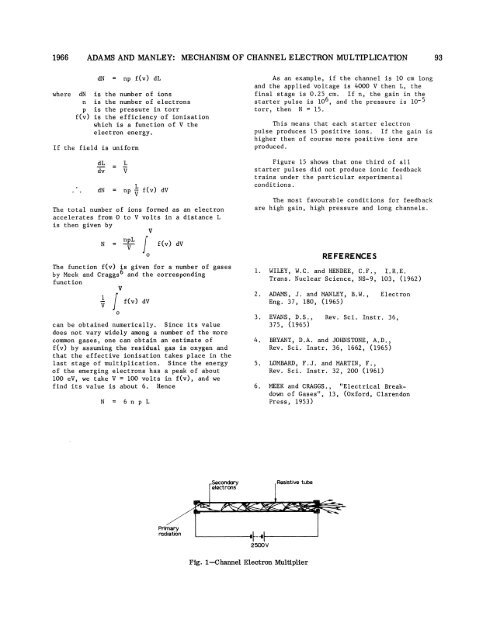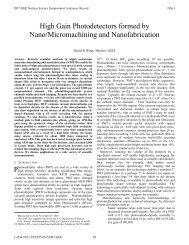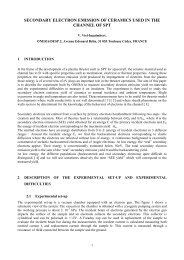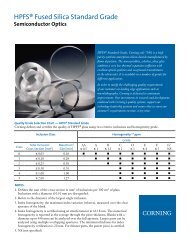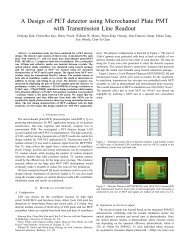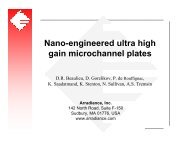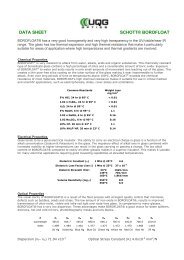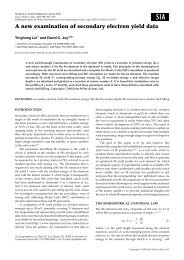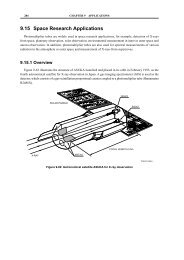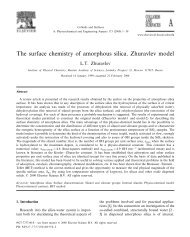the mechanism of channel electron multiplication - IEEE Xplore
the mechanism of channel electron multiplication - IEEE Xplore
the mechanism of channel electron multiplication - IEEE Xplore
You also want an ePaper? Increase the reach of your titles
YUMPU automatically turns print PDFs into web optimized ePapers that Google loves.
1966 ADAMS AND MANLEY: MECHANISM OF CHANNEL ELECTRON MULTIPLICATION<br />
93<br />
dN = np f (v) dL<br />
where dN is <strong>the</strong> number <strong>of</strong> ions<br />
n is <strong>the</strong> number <strong>of</strong> <strong>electron</strong>s<br />
p is <strong>the</strong> pressure in torr<br />
f(v) is <strong>the</strong> efficiency <strong>of</strong> ionisation<br />
which is a function <strong>of</strong> V <strong>the</strong><br />
<strong>electron</strong> energy.<br />
If <strong>the</strong> field is uniform<br />
dL<br />
dv<br />
L<br />
V<br />
dN = np v f(v) dV<br />
The total number <strong>of</strong> ions formed as an <strong>electron</strong><br />
accelerates from 0 to V volts in a distance L<br />
is <strong>the</strong>n given by<br />
V<br />
N npL f(v) dV<br />
The function f(v) is given for a number <strong>of</strong> gases<br />
by Meek and Craggs6 and <strong>the</strong> corresponding<br />
function<br />
V<br />
| f(v) dV<br />
0<br />
can be obtained numerically. Since its value<br />
does not vary widely among a number <strong>of</strong> <strong>the</strong> more<br />
comnon gases, one can obtain an estimate <strong>of</strong><br />
f(v) by assuming <strong>the</strong> residual gas is oxygen and<br />
that <strong>the</strong> effective ionisation takes place in <strong>the</strong><br />
last stage <strong>of</strong> <strong>multiplication</strong>. Since <strong>the</strong> energy<br />
<strong>of</strong> <strong>the</strong> emerging <strong>electron</strong>s has a peak <strong>of</strong> about<br />
100 eV, we take V = 100 volts in f(v), and we<br />
find its value is about 6. Hence<br />
N = 6 n p L<br />
As an example, if <strong>the</strong> <strong>channel</strong> is 10 cm long<br />
and <strong>the</strong> applied voltage is 4000 V <strong>the</strong>n L, <strong>the</strong><br />
final stage is 0.25 cm. If n, <strong>the</strong> gain in <strong>the</strong><br />
starter pulse is 106, and <strong>the</strong> pressure is 10-5<br />
torr, <strong>the</strong>n N = 15.<br />
This means that each starter <strong>electron</strong><br />
pulse produces 15 positive ions. If <strong>the</strong> gain is<br />
higher <strong>the</strong>n <strong>of</strong> course more positive ions are<br />
produced.<br />
Figure 15 shows that one third <strong>of</strong> all<br />
starter pulses did not produce ionic feedback<br />
trains under <strong>the</strong> particular experimental<br />
conditions.<br />
The most favourable conditions for feedback<br />
are high gain, high pressure and long <strong>channel</strong>s.<br />
REFERENCES<br />
1. WILEY., W.C. and HENDEE, C.F., I.R.E.<br />
Trans. Nuclear Science, NS-9, 103, (1962)<br />
2. ADAMS, J. and MANLEY, B.W., Electron<br />
Eng. 37, 180, (1965)<br />
3. EVANS, D.S., Rev. Sci. Instr. 36,<br />
375, (1965)<br />
4. BRYANT, D.A. and JOHNSTONE, A.D.,<br />
Rev. Sci. Instr. 36, 1662, (1965)<br />
5. LOMBARD, F.J. and MARTIN, F.,<br />
Rev. Sci. Instr. 32, 200 (1961)<br />
6. MEEK and CRAGGS., "Electrical Breakdown<br />
<strong>of</strong> Gases", 13, (Oxford, Clarendon<br />
Press, 1953)<br />
Fig. 1-Channel Electron Multiplier


